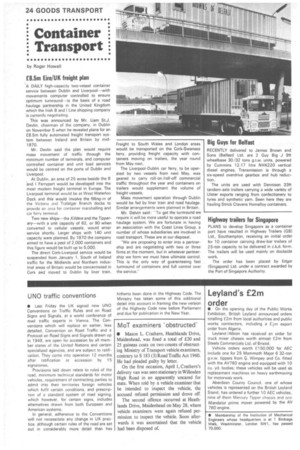Container Transport
Page 26

If you've noticed an error in this article please click here to report it so we can fix it.
by Roger Howell
f8.5m Eire/UK freight plan
A DAILY high-capacity two-vessel container service between Dublin and Liverpool—with movements computer controlled to ensure optimum turnround—is the basis of a road haulage partnership in the United Kingdom which the Irish B and I Line shipping company is currently negotiating.
This was announced by Mr. Liam St.J.
Devlin, chairman of the company, in Dublin on November 5 when he revealed plans for an €3.5m fully automated freight transport system between Ireland and Britain by mid1970.
Mr. Devlin said the plan would require mass movement of traffic through the minimum number of terminals, and computer controlled container and unit load services would be centred on the ports of Dublin and Liverpool.
At Dublin, an area of 25 acres beside the B and I Ferryport would be developed into the most modern freight terminal in Europe. The Liverpool terminal would be at West Waterloo Dock and this would involve the filling-in of the Victoria and Trafalgar Branch docks to provide an area for container marshalling and car ferry terminal.
Two new ships—the Kildare and the Tipperary—with a unit capacity of 62, or 90 when
converted to cellular vessels, would enter service shortly. Larger ships with 140 unit capacity were planned. By 1970 the company aimed to have a pool of 2,000 containers and this figure would be built up to 5,000.
The direct Cork-Liverpool service would be suspended from January 1. South of Ireland traffic for the Midlands and Northern industrial areas of Britain would be concentrated in Cork wild moved to Dublin by liner train. Freight to South Wales and London areas would be transported on the Cork-Swansea ferry, providing freight capacity with containers moving on trailers, the year round from May next.
The Liverpool-Dublin car ferry, to be operated by two vessels from next May, was geared to carry roll-on /roll-off commercial traffic throughout the year and containers on trailers would supplement the volume of freight vessels.
Mass movement operation through Dublin would be fed by liner train and road haulage. Similar arrangements were planned in Britain.
Mr. Delvin said: "To get the turnround we require it will be more useful to operate a road haulage system. We are fortunate in having an association with the Coast Lines Group, a number of whose subsidiaries are involved in road transport. These are at our disposal. • "We are proposing to enter into a partnership and are negotiating with two or three
firms at the moment, but in whatever partnership we form we must have ultimate control. This is the only way of guaranteeing fast turnround of containers and full control over the service. Big Guys for Belfast
RECENTLY delivered to James Brown and Sons (Belfast) Ltd. are 2 Guy Big J 9ft wheelbase 30/32 tons g.t.w. units, powered by Cummins 12.17 litre NHK220 vertical diesel engines. Transmission is -through a six-speed overdrive gearbox and hub reduction, The units are used with Dennison 33ft tandem-axle trailers carrying a wide variety of Ulster exports ranging from confectionery to tyres and synthetic yarn. Seen here they are hauling Strick Cravens Homalloy containers.




















































































































